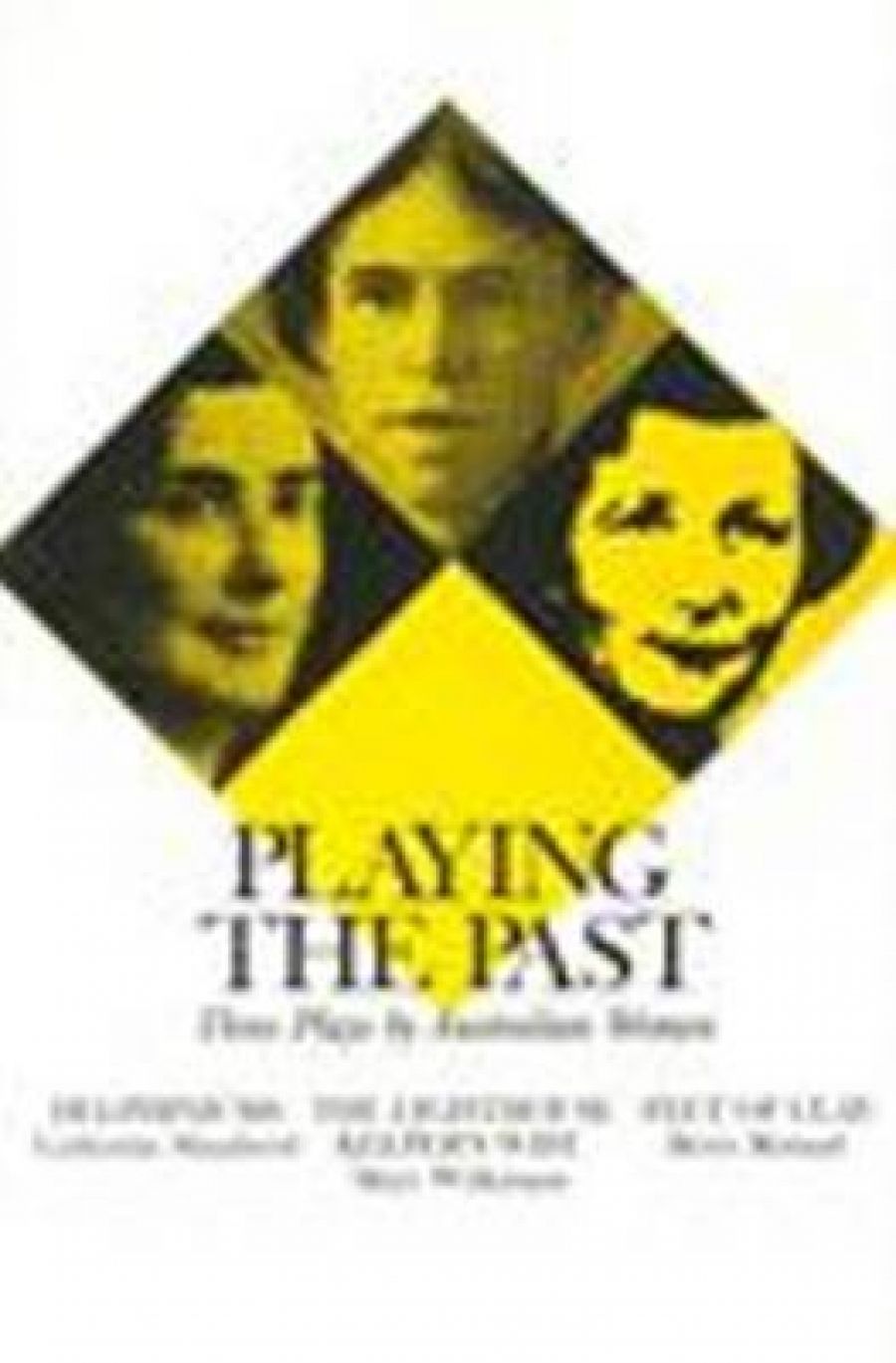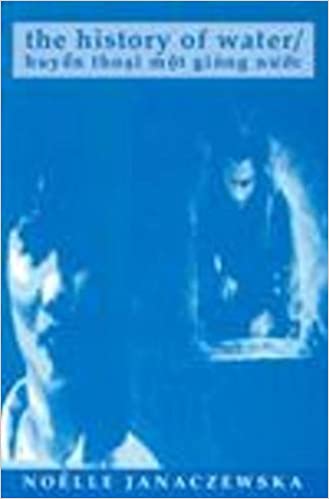
- Free Article: No
- Contents Category: Theatre
- Review Article: Yes
- Article Title: Five plays by women
- Online Only: No
- Custom Highlight Text:
Katherine Brisbane’s Currency Press is the major play-publishing house in the country and no stranger to the snap-freeze process of producing program play texts by women as well as men. The women have a fair representation in Currency’s general range, but they proliferate in the Current Theatre Series, those pre-first production texts so impossible to follow up with the writer’s post-natal reconsiderations.
- Book 1 Title: Playing the Past
- Book 1 Biblio: Currency, $10 pb, 54 pp
- Book 2 Title: The History of Water
- Book 2 Biblio: Currency, $14.95 pb, 56 pp
- Book 2 Cover Small (400 x 600):

What has gone missing until now were the heritage plays by women. Last year Currency’s Australian Drama Project Series was launched with the three playlets revived for the opening of the drama theatre in the new Performing Arts Centre at Monash University. All three are edited by Kerry Kilner with Sue Tweg. Mary E. Wilkinson’s 1922 The Lighthouse Keeper’s Wife is the earliest, and was first published in ‘Art & Letters,’ in Hassell’s Australian Miscellany that year. Betty Roland’s early comedy, Feet of Clay (1928), with an edited opener, appears in print here for the first time. Catherine Shepherd’s Delphiniums (1942) was premiered by the Hobart Repertory Theatre Society in 1943 and published in Six Australian One-Act Plays in 1944.
Wilkinson (1877–1974) was a theosophist and a suffragette, a Melburnian known locally as a poet and short story writer. The Lighthouse Keeper’s Wife is her only complete play to survive and that only because it was published. On stage it comes over, as most of its Australian contemporaries do, as an indigestible mix of melodramatic leftovers from an earlier theatrical tradition and the psychologically undercooked. Her heroine, Mary, all but imprisoned on an island and withering within the conventions of traditional marriage, is betrayed even by the God she trusts. Its themes of isolation and alienation are familiar but the one-act play proves too frail a form for its Gothic burden. Had its writer had a chance to develop within the practical experience of theatre this piece might have appeared in a more robust and durable full-length version. As it is, it seems destined to become fossilised as a literary point of reference.
Betty Roland (1903–96) was from country Victoria. She was a journalist but she was also a member of the Communist Party, and a prolific writer of agit-prop for it in the 1930s. She later turned to writing for the theatre and then to radio scripts to eke out a living both here and in England, yet only one play of hers comes readily to mind. The Touch of Silk had its first professional production in 1988 when the Melbourne Theatre Company rescued it from oblivion, though it had dozens of earlier performances in amateur theatre and on radio. Roland had forgotten the Wildean Feet of Clay, left unproduced and unpublished until Richard Fotheringham unearthed it in the Australian National Archives recently. The theme of the sculptor falling in love with his own creation and unable to decide between marble-turned-flesh and fiancée-turned-suspicious, was hardly new even in 1928, but Roland was a dab-hand at comic dialogue with real social bite hidden under a fashionable urbanity. The piece needs a very slick production to come off at all and reading it requires a memory of Coward’s stage rather than our own, but it kept its place in amateur theatre circles for good reason.
Catherine Shepherd (1902–76) was Rhodesian born and English educated. She migrated to Australia in the early l 920s, living and working as a playwright mostly in Tasmania. She was a founding member of the Hobart Repertory Theatre Society which staged a number of her plays. This experience shows in the careful if conventional craftsmanship employed to construct Delphiniums. She shows an impoverished but decent old couple forced into ever poorer rented rooms and their brutalisation by an already impoverished and brutalised landlady. This pocket-size tragedy plays well and reads well and it is a pity that its writer was ignored and her plays apparently lost, with only nine surviving.
The lesson here is that publication is essential if a fugitive heritage we are only now beginning to search out is not to disappear altogether.
The social concerns of this earlier generation of women writing for the stage match up with those of present writers, though both have a tendency to want to use the stage as an ideological platform rather than engage with the theatrical medium as a discipline. Lack of opportunity to engage with theatre first-hand left that earlier work largely unpolished and often not fully realised, a mini-copy of English models.
Today the stage is being experienced and used by women in quite other ways. Two recent plays from the Current Theatre Series demonstrate a growing awareness by women playwrights of the need to experiment with form and broaden content without reference to prior models from elsewhere.
Noëlle Janaczewska’s preface to her The History of Water (first produced 3 June 1992 at the Wharf Studio by the Sydney Theatre Company) claims this poetic two-voice work as an exploration of ‘the space between learning a new language and living in a new language; the difference between floating on the surface of a culture and being able to chart its depths.’
Against a background of war two women, a British-Australian photographer who photographs only water, and a Vietnamese-Australian translator, dip into childhood memories, trying to anchor the drift of time as they come to terms with internal and external change. A suitcase left abandoned on a ferry by a mysterious man forms a tenuous link between them.
This is not a work that fits easily into the standard definitions of what is dramatic or what constitutes the theatrical experience. More exploratory evocation than play, it still requires the ambience of theatre to realise its potential, charting a delicately dangerous passage between the studio play and the performance piece. As text it reads as something less compressed than poetry and more elevated than dialogue without creating a language of its own. Dual language sections are mercifully brief and serve to pin down problems rather than disturb the rhythms of the play itself.
Anna Broinowski’s The Gap (first produced at the Belvior Street Theatre as part of the Sydney Asian Theatre Season, June 1993) echoes the Janaczewska piece with its use of the two-voice, two-cultures-contact formula. The same problem over the use of a language not spoken by its audience crops up as well, seriously cutting across its concentration. This time the proponents are an Australian tour guide with attitude who works for the ‘Hello Aussie Sunshine Tour Company’ servicing Japanese tourists, and an unhappy young Japanese bride who threatens to end it all at The Gap. There is an attempt here to come to grips with the us-and-them of Australian-Japanese relations, but the play swerves about on the surface, dodging the deeper issues it raises in favour of a hands-across-the-seas ending, which is a pity. Just the same its verve and mad-cap humour make it playable, if not exactly readable.
Broinowski’s play was picked up by Robyn Archer’s National Festival of Australian Theatre in Canberra in 1994 and went to Tokyo’s Theatre Cai later that year. Janaczewska’s was one of the winners of the 1994 London New Play Festival. Its radio adaptation was short-listed for the 1994 NSW State Literary Awards and at the 1995 Berlin Prix Futura – some indication that the times have changed for women who write plays.
For all that, publication remains as important as ever. The published text often acts as the playwright’s visiting card to agents and producers. More – it acts as a major communications tool, placing the play in the hands of a literary audience at a time when second productions are still difficult to achieve in a community only now realising the importance of its own experience in the creative involvement of theatre. We remain a long way from the Irish and the Greek custom of buying a new play at the newsagents along with the day’s papers.


Comments powered by CComment